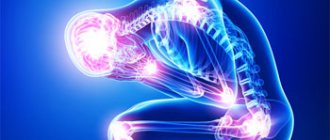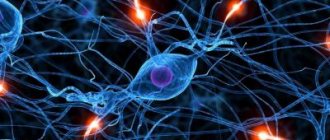Reactive psychosis
– a short-term mental disorder that occurs in response to an intense traumatic situation. Clinical manifestations can vary greatly; they are characterized by disturbances in the perception of the world, inappropriate behavior, the development of psychosis against the background of acute stress, the reflection of stress in the picture of a mental disorder, and the completion of psychosis after the disappearance of traumatic circumstances. Symptoms of reactive psychosis usually appear soon after mental trauma and last from several hours to several months. The diagnosis is made based on history and clinical manifestations. Treatment is pharmacotherapy; after recovery from the psychotic state, psychotherapy.
Reactive paranoid
Reactive paranoid is a psychosis that occurs under the influence of traumatic circumstances: being in a situation of severe conflict, in an alien social environment, in a war zone, in conditions of imprisonment, etc. It develops acutely. Symptoms usually disappear after eliminating the traumatic situation; sometimes a subacute or protracted course of reactive paranoid is observed, resulting in pathological personality development. Detailed studies of this pathology were carried out in the first half of the 20th century by famous Soviet psychiatrists: P.B. Gannushkin, V.A. Gilyarovsky, A.N. Molokhov, E.A. Popov, A.V. Snezhnevsky and others. Subsequently, these studies were supplemented with new data, but views on the causes of development, course and methods of treatment of reactive paranoid have not undergone significant changes since then. Diagnosis and treatment are carried out by specialists in the field of psychiatry.
Treatment approaches
Treatment of reactive psychosis is always carried out by a psychiatrist and is based on an integrated approach. The combination of medications and psychotherapeutic effects is most effective in eliminating the disease.
Use of drugs
Medications act as symptomatic treatment, as they are aimed at eliminating specific symptoms.
The most commonly used groups of drugs are:
- Neuroleptics to eliminate delusions, hallucinations and other productive symptoms. The most commonly used are Triftazine and Haloperidol. It is possible to prescribe atypical antipsychotics, for example, Risperidone.
- For severe psychomotor agitation, tranquilizers (benzodiazepine, etc.) are used. In addition to normalizing the state of the nervous system, they eliminate fear and anxiety, which aggravate the course of the disease.
- Normotimics (lithium salts) are used for fear of death, worries about one’s fate or the lives of loved ones. Drugs in this group stabilize mood and condition.
- Antidepressants are prescribed for depressive disorder. Drugs (Fluoxetine, Amitriptyline, etc.) gradually normalize a person’s mood, reducing the risk of developing prolonged psychosis and other negative consequences of the pathology. When using antidepressants, their effect on the effectiveness and safety of other psychotropic drugs should be carefully studied.
The selection of pharmacotherapy in psychiatry is carried out only by a psychiatrist. All drugs have certain indications and contraindications that must be taken into account when prescribing them.
Psychotherapeutic assistance
Psychotherapy is a key treatment method. If the patient does not have productive symptoms of psychosis in the form of hallucinations and delusions, then recovery is noted after 4-5 sessions with a psychotherapist. The specialist assesses the person’s condition and helps him cope with the traumatic situation he suffered.
It is recommended to initially conduct individual consultations until clinical symptoms disappear. Group psychotherapy is indicated during the rehabilitation period to prevent relapse. Preference in the treatment of reactive changes is given to positive and cognitive-behavioral psychotherapeutic directions.
Causes and classification of reactive paranoid
As the immediate causes of the development of reactive paranoid, experts indicate acute psychotraumatic circumstances, usually associated with a risk to the life, health and future of the patient, or having great subjective significance for the patient. Constant elements of traumatic circumstances that provoke the emergence of reactive paranoid are a high level of uncertainty, lack of information, the inability to assess what is happening from the point of view of usual standards and build a line of behavior that ensures the best outcome in a given situation.
Of great importance are the characteristics of the patient’s character and personality, his somatic condition, as well as the specific conditions of the situation (foreign language environment, imprisonment, etc.). The likelihood of developing reactive paranoid increases with increased sensitivity, anxiety, suspiciousness, suspicion, rigidity of internal attitudes and insufficient flexibility of thinking. Factors contributing to the emergence of reactive paranoid are physical and mental fatigue, exhaustion, poor nutrition, lack of sleep, trauma and somatic illnesses.
Hemorrhoids kill the patient in 79% of cases
Domestic researchers identify the following variants of reactive paranoid:
- Reactive paranoid delusions
- Reactive delusional psychosis
- Induced reactive paranoid
The group of reactive delusional psychoses includes wartime paranoids, prison paranoids, railway paranoids, paranoids when entering a foreign language environment and other types of reactive paranoid that have common clinical symptoms, but differ slightly in external manifestations depending on specific environmental conditions.
Main categories
This condition also has another name – psychogenic disorders. Based on the nature of the flow, two types of these violations are distinguished:
- Hypokinetic is a condition in which a person develops a hysterical stupor - he becomes immobile and loses the ability to speak.
- Hyperkinetic, on the contrary, is characterized by the manifestation of strong physical overexcitation. However, in both forms of the disorder, consciousness becomes clouded, and vegetative symptoms are also noted: tachycardia, pressure changes.
In accordance with the nature of the symptoms, the following types of reactive psychoses are distinguished:
- Acute – occur as a result of exposure to serious stressful circumstances. For example, this could be a threat to a person’s life or news of the death of a loved one.
- Subacute – found most often in psychiatric practice. Awareness of the events taking place gradually covers a person. Paranoid states, stupor, and depression often develop. The condition is characterized by depression, sensitivity, irritability and aggression. Patients may become too touchy, their behavior is characterized by theatricality, as they try with all their might to attract attention to themselves.
- Lingering. The main symptom of this type of reactive psychosis is its duration (six months, a year or more). Most often, the patient gradually develops symptoms of pseudodementia and delusional fantasies. Puerile syndrome may also occur.
In psychiatric practice, there are several variants of hysterical reactive psychosis, the symptoms of which are described below.
Reactive paranoid delusions
The leading symptom of reactive paranoid is the formation of overvalued or delusional ideas directly related to traumatic circumstances. Commonly observed hypochondriacal delusions, litigious delusions, delusions of jealousy, delusions of persecution, or delusions of invention. A characteristic feature of this form of reactive paranoid is the preservation of external adequacy and orderly behavior in other areas of life. The subject of delusional ideas is well understood by others, since they can trace the connection between these ideas and the patient’s current problems.
At the initial stage of reactive paranoid, overvalued and delusional ideas can be corrected. Subsequently, the delirium deepens, the patient becomes less susceptible to the opinions of other people. The duration of the disorder depends on the characteristics and duration of the traumatic situation. When the problem is resolved, reactive paranoid usually quickly reduces and disappears. If the patient remains in an unfavorable psychological atmosphere for a long time and cannot solve the problem, a protracted course may result in pathological paranoid development.
Puerilism
This disorder is characterized by childish behavior, when the patient retains some adult skills (smoking, using cosmetics, etc.), but in general his manners become similar to those of a child. He burrs, distorts words, plays with toys, and cannot answer simple questions or perform any actions. The term “puerilism” was first introduced by E. Dupre at the end of the 19th century, who was studying types of acute reactive psychosis.
Sometimes puerilism occurs simultaneously with hypochondriacal symptoms, when the patient begins to look for signs of a dangerous somatic disorder. In its isolated form, such a variant of the course of psychosis as puerilism is relatively rare.
Reactive delusional psychoses
This form of reactive paranoid develops in extreme circumstances that require rapid adaptation to unusual and often extremely unfavorable conditions: when entering a war zone, during arrest, isolation from the usual environment (when entering a foreign language environment), absolute isolation (when collapsed during an earthquake , in a mine or in a cave). According to P.B. Gannushkin, there are two circumstances that most contribute to the development of reactive paranoid: the first is suspicion of committing a crime, the second is being in a completely alien environment.
Predisposing factors that increase the likelihood of reactive paranoid occurrence are secrecy, anxiety, self-doubt, increased sensitivity, as well as objective circumstances due to which a person hides certain facts and fears exposure. The listed factors create an unfavorable emotional background and sharply increase psychological stress. As a result, a patient suffering from reactive paranoid begins to interpret any neutral events (the behavior and views of others, their conversations among themselves) as evidence of eavesdropping, spying, condemnation or exposure.
Acute or subacute development of reactive paranoid is possible. The first manifestation of psychosis is increasing anxiety and anticipation of an inevitable catastrophe, combined with false recognition and derealization. Patients with reactive paranoid feel that everything that happens has some kind of secret meaning, that other people are planning something, whispering and exchanging glances. The culmination is a feeling of mortal danger. Those around them turn into attackers who are preparing to deal with the patient, taking his life.
Against the background of extremely intense emotional reactions (confusion, anxiety, anxiety and fear), delusions and visual and auditory hallucinations occur. The patient suffering from reactive paranoid “sees” someone sneaking towards him to attack him, “hears” voices threatening or reporting enemy plans. Psychosis without hallucinatory disorders is extremely rare. Delusions of special significance, delusions of influence, delusions of relation, or delusions of persecution usually develop. The theme of delusions in reactive paranoid is directly related to traumatic circumstances. When there is a threat to life, the theme of sudden death dominates; when there is a threat to the future and reputation, the theme of moral damage, humiliation, injustice, etc. dominates.
The elements of delusion are determined by the situation that provoked the development of reactive paranoid. With railway paranoia, the patient may see the neighbors as a gang of thieves planning a robbery and turn to the conductor or police for help. With wartime paranoia, he may consider those around him to be enemies, and himself to be a deserter, traitor or spy. The main manifestations of reactive paranoid usually disappear within a few days after the start of treatment. For 2-3 weeks, asthenia is observed, sometimes with elements of residual delirium.
Why does a violation occur?
The main reason that causes reactive psychosis is the loss of any values by a person. They may concern the life and health of the patient himself and his loved ones, material well-being, personal freedom, and social status. When a person is deprived of these benefits or there is a serious risk of losing them, such a situation begins to strongly contradict his emotional state, which causes a psychogenic illness.
The main cause of the disorder is a reaction to stressful circumstances. It occurs when a person experiences a serious emotional shock. At the same time, the risk group includes those people who have suffered brain injuries in the past, have a hysterical character, or suffer from sleep disorders or alcohol addiction. Teenagers and menopausal people are especially vulnerable during stressful situations. After all, a vegetative factor is imposed on the state of mind.
The disease can also occur due to:
- Alcohol abuse.
- Concomitant somatic disorders.
- Lack of sleep and chronic fatigue.
- Conscription into the army without the desire of the conscript.
- Job losses.
- Family problems that have been unsolved for a long time.
- Treason and betrayal by loved ones.
- Deaths of loved ones (there are known cases of exacerbation caused by the death of a pet).
- Thefts, attacks, threats to life and health from offenders.
- Diagnosis of cancer. It is believed that approximately 85% of patients develop a psychogenic illness after diagnosis. At the same time, a depressed state forces you to give up even a hypothetical chance of recovery. This only brings death closer.
- Responses to a natural disaster.
Induced reactive paranoid
Induced reactive paranoid develops as a result of close, usually long-term, contact with a patient suffering from a mental disorder. Factors contributing to the development of induced paranoid are high emotional intensity during communication between the inductor and the recipient, a lack of other sources of information and external stimuli, a too narrow circle of communication, as well as the high authority of the inducer in the eyes of the recipient.
Induced reactive paranoid more often occurs with self-doubt, anxiety, increased suggestibility, psychopathy and mental retardation. The theme of the recipient's delusions reflects the inductor's delusional ideas. Possible delusions of poisoning, delusions of persecution, litigious delusions, etc. There is no criticism of one’s own state and the state of the inductor. When contact with the inducer is stopped, the symptoms of reactive paranoid are reduced and disappear.
How dangerous is the disease?
In protracted forms, the primary stage in patients (usually depression) goes unnoticed by most others. Against the background of affect disturbance, persistent damage to mental functions occurs. If recovery does not occur, then a complex of negative symptoms is formed, which can be characterized during diagnosis as delusions and hallucinations.
In an unprepared person, psychosis develops quite quickly. The control for which the frontal lobes are responsible weakens. The configuration of nerve connections undergoes changes. The human brain is trying to solve a difficult situation for it. Mental degradation can reach pseudodementia and puerilism, when a person demonstrates the behavior of an infant. The most severe consequence is a paranoid state, in which hallucinations and delusions come to the fore in the patient’s consciousness.
Treatment and prognosis for reactive paranoid
Treatment is carried out in a psychiatric hospital. In the acute phase of reactive paranoid, antipsychotics, anti-anxiety and sedative drugs are used. After eliminating psychotic manifestations, it is possible to use various psychotherapeutic techniques to identify the causes of the development of reactive paranoid, process traumatic experiences and develop new, more adaptive ways of responding. Individual therapy is used.
The prognosis is usually favorable. When the traumatic situation is resolved and a favorable psychological atmosphere is created, the manifestations of reactive paranoid stop within a few days or weeks. After the elimination of psychotic symptoms, asthenia of varying severity is observed, possibly with residual elements of delusion or paranoid experiences. Subsequently, all pathological manifestations disappear, and the outcome of reactive paranoid is complete recovery. Rarely (usually in the presence of defects in the mental constitution) pathological development of personality is observed.











